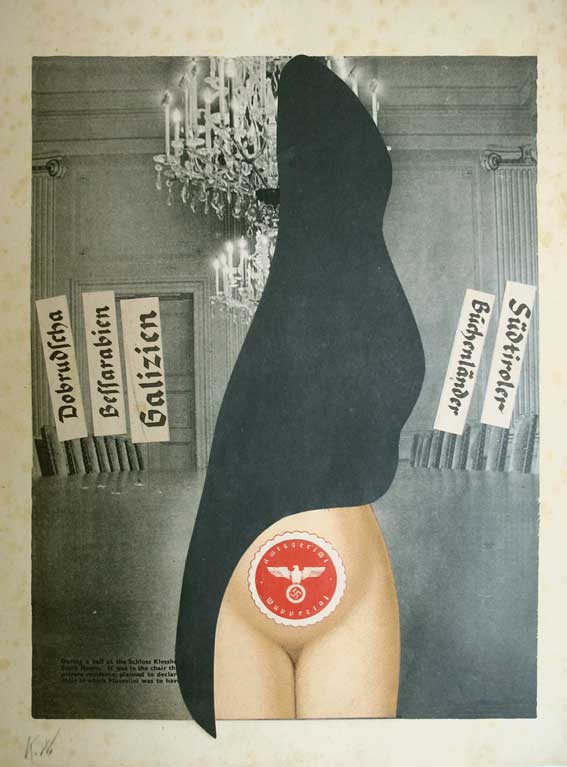 |
Titre
 Участковый суд г. Вупперталь
Участковый суд г. Вупперталь Amtsgericht Wuppertal
Amtsgericht Wuppertal Tribunal De Grande Instance Wuppertal
Tribunal De Grande Instance Wuppertal Local Court Of Wuppertal
Local Court Of WuppertalProvenance
Description
| au centre se trouve une femme nue à moitié cachée par un voile noir, le tout dans une salle de conférence avec un grand lustre. sur les côtés, on voit des petites affiches: dobrudscha, bessarabien, galizien, südtiroler, buchenländer. sur le ventre de la femme se trouve un cachet avec l'aigle et la croix gammée et l'inscription: amtsgericht wuppertal/ tribunal de première instance wuppertal.texte à gauche: during a ball at the schloss klessh.. state room. it was in the chair.. in which mussolini was to... / pendant un bal au chateau klessh... c'était dans la chaise... dans laquelle mussolini... les noms sur les affiches sont des régions où vivait une minorité importante d'allemands. entre 1939 et 1940, des accords avaient été établis avec le gouvernement italien (1939) pour le südtirol et, par la suite, avec le gouvernement soviétique (1939 - 1940) pour renvoyer ces allemands en allemagne ou dans la partie de la pologne gouvernée par l'allemagne: au début en galicie et après en bukowina (= buchenländer), dobrudscha (entre la roumanie et la bulgarie) et bessarabie (entre la roumanie et l'union soviétique). le texte anglais fait référence au château klessheim dans la région de salzburg en autriche, qui était devenu sous hitler son "gästehaus" pour les visiteurs (1940 - 1942). le "salon de réception du 3ème reich" avait un rôle de très grande importance pour la politique anti-bolchévique et le chateau était le centre de coordination des chefs d'état liés contre la russie: mussolini y fut reçu en avril 1943. le cachet avec l'aigle et la croix gammée (gerichtsmarke) sur le ventre de la femme symbolise éventuellement le contrôle du 3ème reich sur les naissances (dans ce cas éventuellement relatif aux allemands impatriés). on pouvait acheter ce type de cachets dans les kiosques. a travers ces cachets, waldmann a peut-être voulu exprimer l'oppression du régime nazi. |
Subject
| in the middle, there is a naked woman partially covered with a black veil in a lecture room with a big chandelier. on both sides, there are small strips of paper with the words: dobrudscha, bessarabien, galizien, südtiroler, buchenländer. text on the left side: during a ball at the schloss klessh.. state room. it was in the chair.. in which mussolini was to... the words on the paper strips are regions were a lot of germans lived. between 1939 and 1940, an agreement has been made with the italian government (1939) for südtyrol and then with the soviet government (1940) to send back all germans to germany, or in the regions of poland ruled by germany; first in galicia, then in bukowina, dobrudscha (between romania and bulgaria) and bessarabia (between romania and the soviet union). the english text refers to the klessheim castle in salzburg, austria, which was hitler's "gästehaus" for his guests (1940-1942). the reception room of the third reich was very important to the anti-bolshevik politics and the castle was the centre of coordination for the leaders against russia; mussolini went there in april 1943. the stamp with the eagle and the swastika on the woman's belly might represent the control of the nazis over the births. these types of stamps were available in kiosks. through the stamps, waldmann might have wanted to express the nazi oppression. |
Vous voulez apportez votre contribution sur la compréhension de cette oeuvre ?
(sujet, référence politique, historique, reconnaissance d´un personnage, etc...)